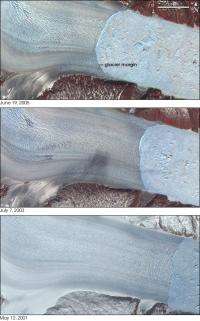March 11, 2013 report
Study finds iron from glacial melting serves as significant source of iron to North Atlantic Ocean

(Phys.org) —A team of researchers from Woods Hole Oceanographic Institution in the US has found significant amounts of particulate iron in runoff from glacial melting in Greenland. Their paper is published today in Nature Geoscience.
The researchers note that only recently have scientists begun to look closely at the contents of glacial melt, which other researchers have estimated is currently causing a sea level rise of approximately 3 mm a year. To learn more they have been examining the water at the base of three of Greenland's glaciers. In so doing they discovered iron concentrations in the micromolar range for both dissolved and particulate iron.
They noted that particulate iron concentrations were far more plentiful than were those that were dissolved and that approximately half of the particulate iron observed was in a form that could be used by plants and animals that live in the sea. All told, their measurements indicate that the entire ice sheet is likely releasing approximately 0.3 Tg. of such iron per year. This they add, is roughly equivalent to the amount of nutrient iron carried into the Atlantic ocean via dust carried in the wind.
More iron in the ocean would likely spur the growth of algae, past studies suggest, which would eventually die and drift down to the sea floor, effectively sequestering the carbon dioxide they consume while alive. Thus, the addition of new iron concentrations as global warming heats and melts Greenland's glaciers, could serve as a break on such warming, slowing the rate at which the planet heats up.
On the other hand, it might not. Algae needs more than just an infusion of iron to flourish—to grow in amounts large enough to impact global warming would require a significant increase in the amount of phosphates and nitrates in the sea as well.
Thus far the researchers have not expanded their research to learn how much of the iron from glacier melt actually reaches the open ocean, or to study whether the increase in iron has led to an actual increase in algae levels—for that reason, the team says they cannot conclude that the increase is having any real current impact on global warming. More research will have to be conducted before such assertions can be made.
More information: Greenland meltwater as a significant and potentially bioavailable source of iron to the ocean, Nature Geoscience (2013) doi:10.1038/ngeo1746
Abstract
The micronutrient iron is thought to limit primary productivity in large regions of the global ocean. Ice sheets and glaciers have been shown to deliver bioavailable iron to the coastal and open ocean in the form of sediment released from the base of icebergs and glacially derived dust. More direct measurements from glacial runoff are limited, but iron concentrations are thought to be in the nanomolar range. Here we present measurements of dissolved and particulate iron concentrations in glacial meltwater from the southwest margin of the Greenland ice sheet. We report micromolar concentrations of dissolved and particulate iron. Particulate iron concentrations were on average an order of magnitude higher than those of dissolved iron, and around 50% of this particulate iron was deemed to be potentially bioavailable, on the basis of experimental leaching. If our observations are scalable to the entire ice sheet, then the annual flux of dissolved and potentially bioavailable particulate iron to the North Atlantic Ocean would be approximately 0.3 Tg. This is comparable to dust-derived soluble iron inputs to the North Atlantic. We suggest that glacial runoff serves as a significant source of bioavailable iron to surrounding coastal oceans, which is likely to increase as melting of the Greenland ice sheet escalates under climate warming.
Journal information: Nature Geoscience
© 2013 Phys.org


















